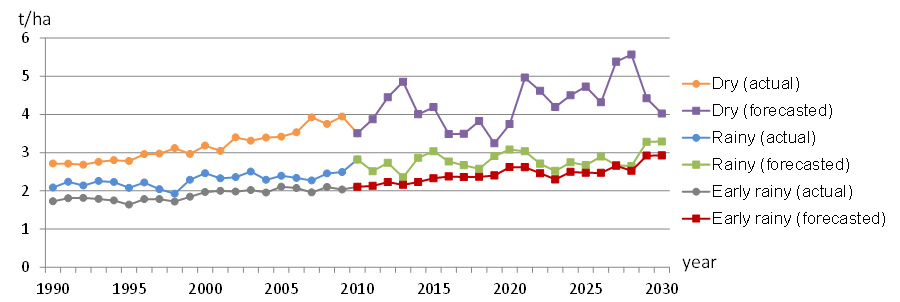Estimation of cost and effect of food policy to mitigate rice price variation under climate change in Bangladesh
Description
Bangladesh is located downstream of large international rivers and along the path of tropical storms, making the country prone to natural disasters and its agricultural production unstable. According to recent meteorological observations, the frequency of higher temperatures is increasing, and climate change is projected to affect the crop yields more severely in the future. To cope with the instability in agricultural production, policy tools for climate change adaptation as well as adaptation technology development are important. In this study, we estimated the cost and effect of procurement and distribution policies in mitigating rice price variation under climate change.
To estimate the policy cost and effect, we developed a rice supply-demand model in Bangladesh, based on analysis of statistical data related to paddy area, rice production, price, import and export, stock level, GDP, and population. We also estimated the yield functions of different seasonal rice, based on yield statistics and meteorological data, so we can forecast climate change impacts on rice yield. To analyze the policy, we added a policy model consisting of procurement and distribution functions. By assuming that the amount of procurement and distribution are decided by farmers’ and consumers’ decision-making on trade partners, with the difference between governmental and market prices as the main incentive and subject to physical constraints related to rice storage capacity and actual stock, we can apply the Tobit model to estimate procurement and distribution functions.
We made outlooks under the IPCC climate RCP6.0 and socioeconomic SSP2 scenarios, with 2010 to 2030 as the forecast period. When inputting future climate data from the global circulation model (MIROC5) into the yield model, rice yields show an increasing trend in the ranges of variation (Table 1 and Fig. 1), implying greater rice market instability and food policy importance. Figure 2 shows two rice price forecasts. The green line shows baseline and the blue line shows a new policy in which more intensive policy intervention is conducted by reducing the distribution price and increasing the procurement price when the price difference from the trend line is more than 10%. As the figure shows, the new policy reduces the range of price variation. Reduction in price variation is almost 2.34% points (Table 2). Additional policy costs per year for this variation reduction are estimated to be US$14 million for facility construction and maintenance, US$195 million for rice stock quality maintenance, and US$183 million for rice transaction. In addition, storage capacity needs to be increased from 1.7 million tons to 3 million tons.
There are some other climate change and socioeconomic scenarios and different global circulation models. Therefore, the result of this study based on certain scenarios and a model is not the sole outlook. However, this result can provide basic information for food policy making in the era of climate change and for assessing adaptation technologies.
Figure, table
-
Fig. 1. Actual and forecasted rice yields of improved varieties for different rice seasons
-
Table 1. Rice yield variation and climate change impact
Rice seasonCoefficient of variation (%)Climate impactUntil 20092010 - 2030(% point)Early rainy (Aus)8.329.300.98Rainy (Aman)7.768.720.96Dry (Boro)12.2814.62.32 -
Fig. 2. Stabilization of rice price by an intensified food policy (farm gate price)
-
Table 2. Rice price variation and policy effect
Price typeCoefficient of variation (%)Policy effectBaselineNew policy(% point)Farm gate19.8517.5–2.35Retail25.7523.42–2.33
- Affiliation
-
Japan International Research Center for Agricultural Sciences Social Sciences Division
- Research project
- Program name
- Term of research
-
FY2016(FY2011~FY2020)
- Responsible researcher
-
Kobayashi Shintaro ( Social Sciences Division )
Furuya Jun ( Social Sciences Division )
MIERUKA ID: 001740Salam Md. Abdus ( University of Tsukuba )
Alamgir Md. Shah ( University of Tsukuba )
- ほか
- Japanese PDF
-
A4 306.08 KB
A3 230.71 KB
- English PDF
-
A4 697.72 KB
A3 512.91 KB
- Poster PDF
-
Poster 358.25 KB


